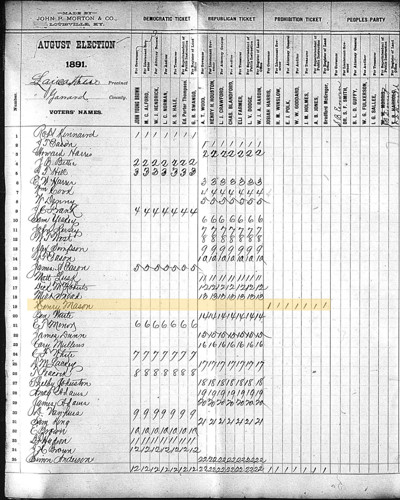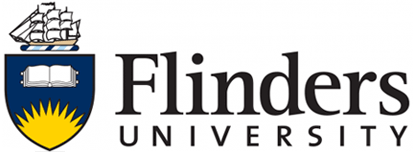

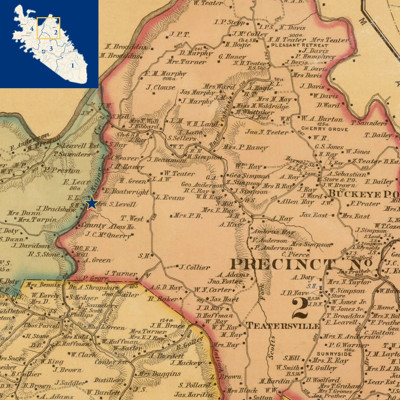
Edited detail from the 1879 Beers and Lanagan map, which shows Squire Turner Leavell’s Sugar Creek property (inherited by his wife in 1869) where Henry Mason likely grew up.
University of Wisconsin-Milwaukee Libraries.
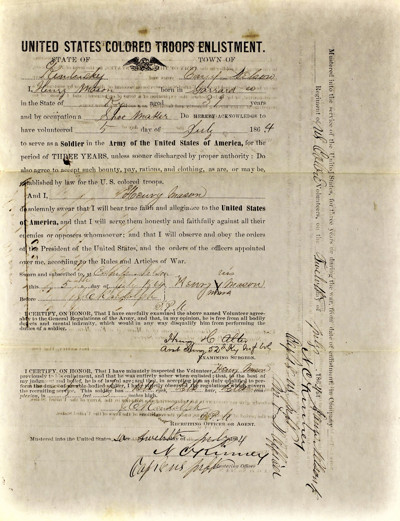
The front page of Henry Mason’s enlistment papers from Camp Nelson with Mason’s “mark” – an “x” – swearing his allegiance to the Union.
National Archives, Civil War Service Records, Colored Troops.
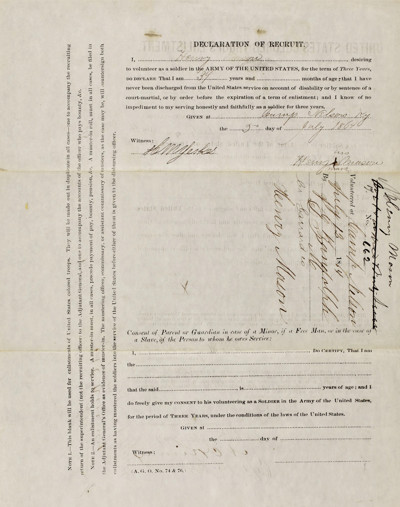
The back page of Henry Mason’s enlistment papers from Camp Nelson, with a blank owner’s consent section at the bottom.
National Archives, Civil War Service Records, Colored Troops.
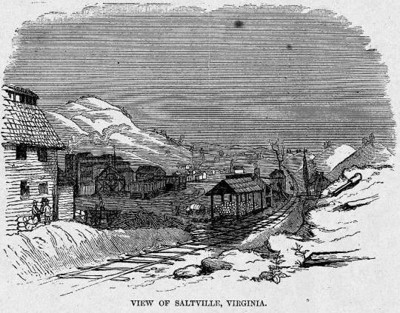
An illustration of Saltville during the Civil War entitled “A View of Saltville, Virginia.”
n.d. Virginia Humanities.
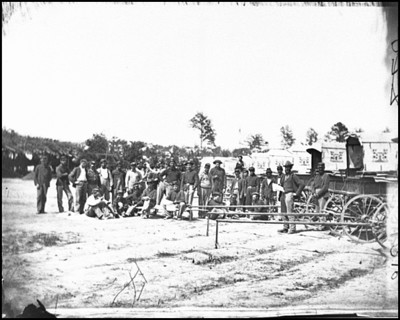
Photographs of men and wagons of the Engineer Corps ambulance train in Falmouth, VA, in April 1863.
O'Sullivan, 1863, Library of Congress.
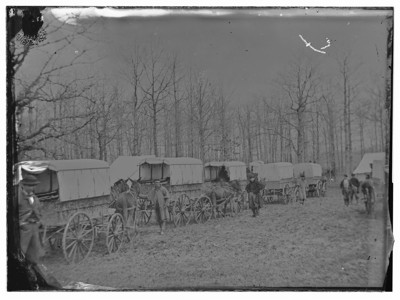
An ambulance train at Harewood Hospital, Washington, D.C. in July 1863.
Miller, 1863, Library of Congress.
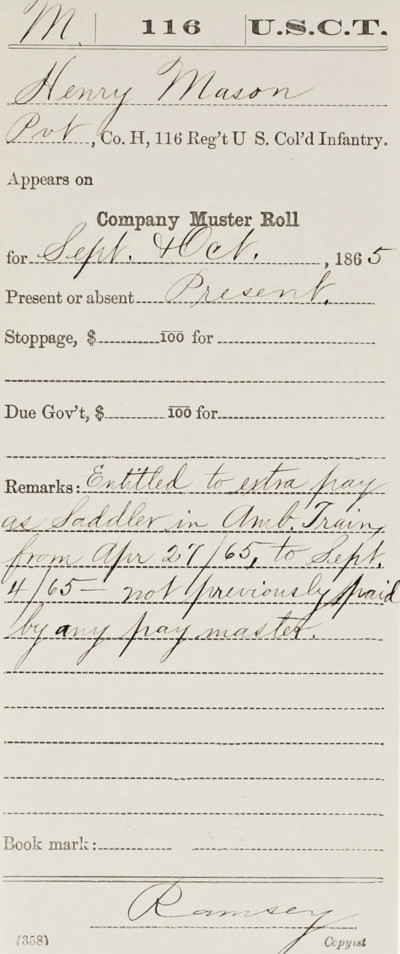
Mason’s muster roll from October 1865, documenting his work as a saddler in an ambulance train.
National Archives, Civil War Service Records, Colored Troops.

Edited detail from the 1879 Beers and Lanagan map, which shows Henry Mason’s home in Lancaster.
University of Wisconsin-Milwaukee Libraries.
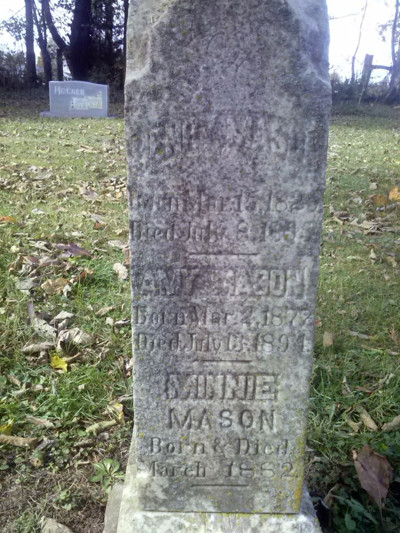
The headstone for Henry Mason and his daughters, Amy and Minnie, at the Lancaster Cemetery.
findagrave.com
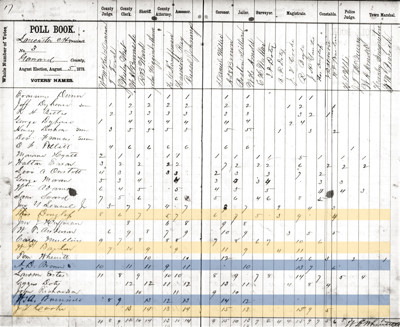
The 17th page of the poll book for the August 1878 county election at Lancaster courthouse, with the votes of the candidates up for office highlighted (blue denotes Democratic Party candidates; yellow is for candidates to formally nonpartisan offices).
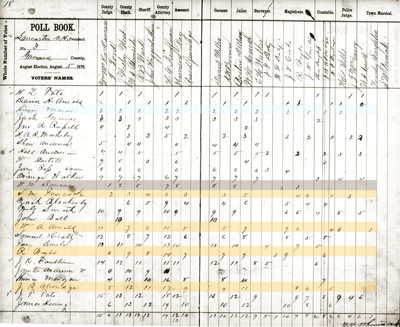
The 18th page of the poll book for the August 1878 county election at Lancaster courthouse, showing Henry Mason’s vote (the third voter from the top) with the votes of the candidates up for office highlighted (brown denotes the Republican candidate, William McKee Duncan; yellow is for candidates to formally nonpartisan offices).
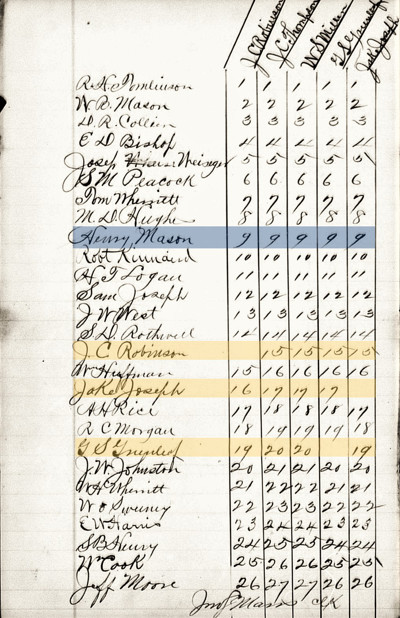
The first page of the 1888 Lancaster town trustee election poll book showing the votes of Henry Mason (highlighted in blue) and trustee candidates (highlighted in yellow).
Henry Mason:
Shoemaker with a Fiercely Independent Political Soul
Monday, August 1, 1870, was Election Day in Garrard County. And it was the first election in which Henry Mason, a black man aged 45, could vote.
Mason, closely connected to the white Republican Party elite, quickly became an avid and independent political participant, voting—often in the early hours of the morning—in five of the six Lancaster elections for which we have been able to collect data.
Despite his close connections to the Republican Party and the existence of public viva voce voting, Mason was no party hack. In the 1870 election, Mason abstained from voting for the Republican candidate for Jailer. In later years, he would vote for Democratic candidates and the Prohibition Party. Reflecting his independence and commitment to democracy, he once declared aloud his vote for the Republican candidates in front of the Democratic candidate for the same office. Mason also often brought his friends and neighbors out to the polls.
In this story, we explore the makings of this fiercely independent and committed political voice.
Enlisting in the Union Army
Henry Mason was born into slavery in Garrard County around 1825. He likely grew up near Sugar Creek in Buckeye precinct, where his owner, Squire Turner Leavell, owned 55 acres. Mason was a skilled leather worker and was a shoemaker in his young adulthood, before, at the age of 39, and with a new baby to support, he decided to enlist in the Union Army.
The day after Independence Day in 1864 Mason successfully enlisted at Camp Nelson. Corporal Mason does not appear to have had Leavell’s consent, as the section of his enlistment papers in which Leavell would have indicated that he had manumitted his slave, is conspicuously blank. This means that Mason, unlike many other slaves, may not have gotten his freedom upon enlistment.
Mason was mustered into Company H of the 116th Colored Infantry on July 12, 1864, at Camp Nelson. He served with his unit until September 15, when he was detached to serve under General Stephen Burbridge, who became known among anti-Union groups as the “Butcher of Kentucky” for his ruthless tactics against Confederate guerrillas.
Witnessing Racism at its Most Extreme
It is likely that Mason served under Burbridge’s command in the doomed first battle of Saltville on October 2, 1864, in which he would have seen racial hatred at its most extreme. This battle, over confederate saltworks in the mountains of south-western Virginia, was an abject failure for the Union. The Confederate Army quickly repelled the advancing troops.
For many of the Confederates there, it may have been the first time they had seen black men fighting alongside white men. Tens of Union soldiers, both black and white, were killed, Burbridge retreated, and Confederates murdered a disputed number of injured black soldiers in what became known as the “Saltville Massacre.”
Mason survived Saltville and rejoined Company H, which had been dispatched to eastern Virginia to take part in the Richmond–Petersburg campaign. Less than two months after Saltville, on November 22, Corporal Mason was demoted to Private Mason, for reasons that we are unable to discern.
Using his Leatherworking Skills
After the Breakthrough at Petersburg on April 2, 1865, which quickly precipitated the surrender of General Robert E Lee one week later, Private Mason was once again detached from Company H. This time his leatherworking skills were put to use, as a saddler and harness maker for the US Ambulance Corps. Based at Ringgold Barracks, in southern Texas on the border with Mexico, Mason worked on the ambulance train for five months until September 1865. It’s possible that Mason’s ambulance train attended to the injured during the final battle of the Civil War, the Battle of Palmito Ranch, just 100 miles east of Ringgold, in May 1865.
Throughout 1865, Mason’s muster rolls repeatedly noted that he was eligible for extra wages as a saddler, and that his extra pay had not yet been paid.
He filled the remainder of his service in Texas and Louisiana and was mustered out in New Orleans on January 17, 1867. As was common for members of the 116th Infantry, his mustering out papers noted “whether free or slave not known.”
Returning to Garrard County
Mason made the 700-mile journey from New Orleans back to Garrard County with wages from his service in his pocket. For many former slaves, wages from service in the Union army was the only wealth they had ever acquired.
By 1870, Mason had reunited with his wife, Ann, and his now seven-year-old daughter, Mary. Using his savings and making decent money as a shoe and bootmaker, Henry had purchased a small residence in “Battle Row,” a black neighborhood to the northeast of the courthouse, near the home of George Denny Jr. Mason’s home was valued at $500, overshadowed by the real estate valuations of his neighbor, Allen Burton ($80,200, though this valuation included some property up in Minnesota). In the 1870 U.S. Census, Henry and Ann had living with them Katie Landrum, a 70-year-old black woman who served as their cook, and James H. Arnold, a 33-year-old farm laborer.
Ann died, likely during the birth of their second child, William, in 1873. Henry moved to a larger home in the other black neighborhood of Lancaster, known as “Duncantown,” in the southwest of town. He soon married Harriet Jones (in 1876), and they had their first child, Amy, in 1877 and a second in 1880. Henry remained in Lancaster until his death in 1895. According to the 1890 U.S. Census of Civil War Veterans, the war left him with fistula and rheumatism in the last 30 years of his life.
Henry was one of the more prominent black men in Lancaster. His home is marked on the 1879 Beers and Lanagan ownership map, reflecting his proud status as a homeowner. His grave is marked by an elaborate headstone (shared with two of his daughters who passed before him), which was unusual for black men at the time.
His second wife, Harriet, lived to about 100 years old. She discussed her youth, as personal property of farmer Beriah M. Jones, for the Slave Narrative Project (note: this historical document reflects the racial mores of the 1930s.) Harriet remained in Lancaster and, in 1940, lived with her surviving children, one of whom became a teacher at the town’s public high school.
Hesitant, But Well-connected Voter in 1870
On August 1, 1870, Mason headed to the polls late in the day, voting in the last Republican surge before polls closed at 7pm. He voted among prominent white men, with Robert D. Lusk and James M. Sanders following him immediately and Allen A. Burton a few voters later.
Lusk was a wealthy attorney who was part of the contingent of local lawyers that formed the inner core of the Republican Party of Garrard County. His brother, Samuel Lusk, was a state legislator and judge, and close friend of Abraham Lincoln. Robert was county attorney in 1860 and shared a legal practice with Robert McAffee Bradley, the father of the 1870 Republican candidate for county attorney (William O. Bradley).
Sanders was one of the wealthiest Republicans in the county.
Burton was one of the earliest anti-slavery voices in Lancaster. Reflecting his deeply Republican networks, Burton had trained William O. Bradley and was related to the Lusks through marriage. Burton attended the 1860 Republican convention in Chicago (which nominated then largely unknown Abraham Lincoln) and was chosen to be a Republican elector. After the election, President Lincoln appointed him ambassador to Columbia.
It was no accident that Mason voted among the white elite of the Republican movement. Mason lived next door to Burton and a few doors down from George Denny Jr., the chief political strategist of the local Republican Party and the Republican candidate for County Judge in the 1870 election.
Although surrounded by prominent Republicans, it may be that Mason was not an eager first-time voter. He ran his own shoemaking business and may not have wanted to upset his Democratic customers by publicly declaring his allegiance to their political opponents.
Perhaps he was convinced or coerced to vote by Lusk or other members of the Republican Party machine. The party machine had been tracking and tallying the vote all day and, toward the end of the day, were mobilized in a desperate effort to secure a Republican victory. Ultimately, the Republican ticket failed at the Lancaster polling place, but prevailed across the County.
Once up on the platform, Mason declared his vote for the Republican ticket for all offices but Jailer. While Mason may have succumbed to political pressure to vote in 1870, he certainly would never do so when it came to his vote choice.
Frequent and Fiercely Independent Political Participant
After dipping his toe in politics in 1870, Henry became one of the most frequent political participants in the county. He missed only one of the six elections held at Lancaster courthouse for which we have uncovered preserved poll books: the November 1876 presidential election, in which Republican Rutherford B. Hayes defeated Democrat Samuel J. Tilden.
Mason was an unusual political participant though. He stands out among African American voters in that he often voted among white Democrats and often for candidates other than Republicans. As his first dissenting voting suggested, he was not an instrument of the Republican machine.
August 1876 County Election
In the August 1876 election, Mason voted early in the day, before the summer sun got too high in the sky. He lined up at the polls with his old next-door neighbor, James Anderson , and his new neighbors, hotel clerk Jesse Huffman and laborer Sam Yakey. Mason also brought with him his white colleague and neighbor, Johann John. John was a bootmaker, like Mason. A migrant from Switzerland who was new to Garrard County, he was unlikely to have been deeply imbued with American racial attitudes. Perhaps reflecting that absence, John voted with Mason in the middle of a large group of black men.
The August 1876 election was an unusual election. There was a Republican candidate for only one of the three offices up for election. Yet the contest stirred the passions of the African American community in Lancaster. 70% of eligible black men turned out, compared to 51% of eligible white men.
We do not know why this election was so mobilizing for black men. But we do know that Mason, like most other black voters, voted for the Republican candidate for sheriff, and a known Democrat, Edward D. Bishop, for constable. Black voters who resided within the town were split between abstaining for town marshal and voting for the Democratic candidate, Isaac Singleton. Singleton was a close neighbor of the widow and children of Squire Turner Leavell (Mason’s former owner). Mason did not vote for Singleton.
August 1878 County Election
In August 1878, Mason was once again one of the last voters of the day. Perhaps avoiding the harsh heat of the summer, Mason turned up at the polls as the candidates for office started declaring their votes. By tradition, candidates waited until the end of the day and declared their vote for each candidate on their party’s ticket except for themselves. Voting for one’s self was regarded as vulgar, and so candidates voted for their opposing candidate or, if that was too distasteful, skipped voting for the office entirely.
Mason was the 445th voter of the day (of 471 voters in total). He voted just after a group of mostly Democratic candidates, including A.D. Brown, Democratic candidate for coroner, and William A. Burnside, Democratic candidate for county clerk.
Mason ascended the courthouse platform and declared aloud his vote for Republican J. Wesley West, Burnside’s competitor for the clerk position, likely within earshot of Burnside.
But he was not a lone Republican. Mason was followed less than 10 voters later by the only Republican candidate to vote at the Lancaster courthouse that day, William McKee Duncan, candidate for county judge.
March 1888 Town election
The town election in Lancaster in June 1888 was a local affair. Five candidates ran for the five town trustee seats and each of the 52 voters voted for them. There were only five black voters the whole day. Turnout of black men was low (34% versus 81% for white men), as it always was for local elections.
Henry Mason was the first black man to declare his vote, performatively voting for all five candidates, voting ninth, among the white civil servants and business owners of the small town. Before him came a lawyer, the Circuit Court clerk, a storekeeper, dry goods clerk, bar keeper, and teacher. Just after him, a bank clerk. We will never know if it was civic duty or the need to curry favor with his patrons that drove him to vote that day. But Mason certainly stood out.
August 1891 Gubernatorial Election
Switching gears to a more competitive election, in the 1891 gubernatorial election, Mason once again demonstrated his independence. He arrived at the polls in the first group of black voters to ascend the steps of the courthouse and cast their votes. He voted with his black neighbors and those with whom he served in the war [link to story about vets]. While they all voted for the Republican ticket, Mason was the only voter for the whole day to vote for the Prohibition Party. Perhaps his wife, Harriet, who had become deeply involved in the local Methodist church after the cholera epidemic of the 1870s, had convinced him of the merits of temperance. In any case, Mason once again stood out.
We don’t know if or how Henry Mason voted after 1891, but it is likely that he kept on voting, using the secret ballot, up until his death in 1895.


